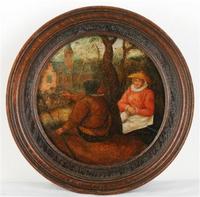I've been holding onto this article about three pervasive wine myths from The Professional Friends of Wine for a few weeks now, reading and rereading it. It's finally time to share it with you, loyal readers. Take a look, learn something new, and then I command you to go out tonight and drink some wine!
Recently in Media Category
The other day I came across an article about a Belgian beer brewed during the full moon, which claims that, apparently, yeast is more active during the full moon, giving the beer "an extra punch."
Is that really true? I'd like to hear from some brewers about this. Do you want a quick, vigorous fermentation, or a long, slow one? Does the speed of fermentation really affect the flavor of the beer that much in the end? My impression has always been that a faster fermentation means that the wort is warmer than usual, and that yeast fermenting in hotter environments can produce strange off flavors. But in this beer's case, the speed comes from the full moon. I mean, if that can actually happen.
Homebrewers, brewmasters, chime in and let us know what's up with this sort of thing.
I read on Dr. Vino's Wine Blog about a meeting of Italian sommeliers, wine journalists, and wine bloggers who were given blind tastings of a variety of fine Barberas. It doesn't seem like too much of a surprise that the heavily oaked versions were not as well-received as those without much oak, but the former were supposed to be the premium products. Tom's Wine Line has more (he was there), including a great quote from Fabrizio Iuli of Monferrato Barbera: "It is a very trivial idea to think that oak makes a wine important."
There has been a lot of oak going into beer these days. Sometimes it turns out pretty good, but other times it can be harsh and strange. Frequently one will hear the flavors of oak being described as "vanilla," but that always seems like a stretch to me. It seems, also, that an oaked beer in a keg will mellow out considerably after a month or two, so if you have a favorite (such as the Deschutes Jubel 2010), try to revisit it a few months after its release, if you can still find it, and notice the differences.
There has been a lot of oak going into beer these days. Sometimes it turns out pretty good, but other times it can be harsh and strange. Frequently one will hear the flavors of oak being described as "vanilla," but that always seems like a stretch to me. It seems, also, that an oaked beer in a keg will mellow out considerably after a month or two, so if you have a favorite (such as the Deschutes Jubel 2010), try to revisit it a few months after its release, if you can still find it, and notice the differences.
As seen on Beernews.org and the Mutineer Magazine Blog, Monster Beverage Co., the makers of Monster Energy Drink, are going after Rock Art Brewery, a small Vermont brewer for naming one of their beers "Vermonster." Is this really what a giant corporation should be doing? Watch the video and feel disgusted, folks.
 One of my heroes of sartorial splendor, Lord Whimsy, writes in The Affected Provincial's Companion, Vol 1, "[To] equate money with style is in grave error: Surely money can grant easy passage to exclusive luxuries and rarefied pleasures, but it is by no means the sole path to a life of enchantment." He then proceeds to advocate thrift stores, flea markets, yard sales, and consignment shops as excellent venues for the discovery of sartorial treasures. What he doesn't mention, however, are the wonderful pieces of surprise artwork that one can sometimes stumble upon.
One of my heroes of sartorial splendor, Lord Whimsy, writes in The Affected Provincial's Companion, Vol 1, "[To] equate money with style is in grave error: Surely money can grant easy passage to exclusive luxuries and rarefied pleasures, but it is by no means the sole path to a life of enchantment." He then proceeds to advocate thrift stores, flea markets, yard sales, and consignment shops as excellent venues for the discovery of sartorial treasures. What he doesn't mention, however, are the wonderful pieces of surprise artwork that one can sometimes stumble upon.Recently, for example, a very lucky woman discovered a piece of work by Pieter Brueghel the Younger that ended up being appraised at about €100,000! The discerning tramp aesthete, I suspect, should hold out for works by Brueghel the Elder, Pieter's more talented father, but perhaps one should simply take what one can find. In any case, keep your eyes open the next time you're forced to attend an estate sale, for you never know what treasures you may come across!

 By
By 














